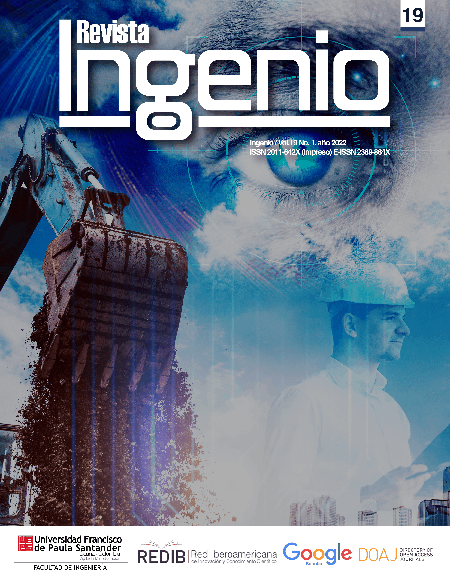Intelligent communication protocol for an architecture focused on the internet of things as a solution to interopera-bility challenges
Protocolo de comunicación inteligente para una arquitectura enfocada en internet de las cosas
Main Article Content
The goal of the Internet of Things is to have smart sensors collaborating directly without human participation, enabling physical objects to see, hear and think in a way that allows them to share information and coordinate decisions. Currently, there are communication protocols for the Internet of Things that meet certain requirements that it demands, however, few are the jobs that allow intelligent information processing, leaving this analysis in charge of other components of the architecture. In this work, a communication protocol is proposed for an architecture focused on the Internet of Things based on Representational State Transfer (REST) combined with the publish / subscribe methodology with messaging service infrastructure. The protocol can manage a large number of devices, has a compact message format so that it requires little processing capacity, uses the Java programming language with interoperability in mind, uses sockets to allow a large number of simultaneous communications and implements intelligent agents for the construction of meaningful messages for decision making.
Downloads
Publication Facts
Reviewer profiles N/A
Author statements
Indexed in
- Academic society
- Universidad Francisco de Paula Santander
- Publisher
- Universidad Francisco de Paula Santander
Article Details
S. Vashi, J. Ram, J. Modi, S. Verma, and C. Prakash,“Internet of Things (IoT): A vision, architectural elements, and security issues,” 2017. Doi: https://doi.org/10.1109/I-SMAC.2017.8058399
R. M. Gomathi, G. H. S. Krishna, E. Brumancia, and Y. M. Dhas, “A Survey on IoT Technologies, Evolution and Architecture,” 2018. Doi: https://doi.org/10.1109/ICCCSP.2018.8452820
K. L. M. Ang and J. K. P. Seng, “Application Specific Internet of Things (ASIoTs): Taxonomy, Applications, Use Case and Future Directions,” IEEE Access, 2019. Doi: https://doi.org/10.1109/ACCESS.2019.2907793
B. TORĞUL, L. Şağbanşua, and F. B. Balo, “Internet of Things: A Survey,” International Journal of Applied Mathematics, Electronics and Computers, 2016. Doi:https://doi.org/10.18100/ijamec.267197
J. Lin, W. Yu, N. Zhang, X. Yang, H. Zhang, and W. Zhao, “A Survey on Internet of Things: Architecture, Enabling Technologies, Security and Privacy, and Applications,” IEEE Internet of Things Journal, 2017. Doi: https://doi.org/10.1109/JIOT.2017.2683200
I. Yaqoob et al., “Internet of Things Architecture:Recent Advances, Taxonomy, Requirements, and Open Challenges,” IEEE Wireless Communications, vol. 24(3), pp. 10–16, Jun. 2017. Doi: https://doi.org/10.1109/MWC.2017.1600421
A. Čolaković and M. Hadžialić, “Internet of Things (IoT): A review of enabling technologies, challenges, and open research issues,” Computer Networks, vol. 144, pp. 17–39, 2018. Doi: https://doi.org/10.1016/j.comnet.2018.07.017
M. Bharti, R. Kumar, and S. Saxena, “Architectural Survey on Internet-of-Things,” 2019. Doi: https://doi.org/10.1109/ICIIP47207.2019.8985897
A. I. A. Ahmed et al., “Service management for iot: Requirements, taxonomy, recent advances and open research challenges,” IEEE Access, vol. 7, pp. 155472–155488, 2019. Doi: https://doi.org/10.1109/ACCESS.2019.2948027
W. Yu et al., “A Survey on the Edge Computing for the Internet of Things,” IEEE Access, vol. 6, pp. 6900–6919, 2018. Doi: https://doi.org/10.1109/ACCESS.2017.2778504
M. Noura, M. Atiquzzaman, and M. Gaedke, “Interoperability in Internet of Things: Taxonomies and Open Challenges,” Mobile Networks and Applications,2019. Doi: https://doi.org/10.1007/s11036-018-1089-9
F. E. Martínez Pérez, “Interfaz portable utilizando Internet y tecnología Orientada a Aspectos, para la definición de tareas robotizadas basadas en visión computacional,” M.S. thesis. Universidad Autónoma de San Luis Potosí, 2005
V. Gazis, “A Survey of Standards for Machineto-Machine and the Internet of Things,” IEEE Communications Surveys and Tutorials, 2017. Doi: https://doi.org/10.1109/COMST.2016.2592948
G. Fortino, W. Russo, C. Savaglio, W. Shen, and M. Zhou, “Agent-oriented cooperative smart objects: From IoT system design to implementation,” IEEE Transactions on Systems, Man, and Cybernetics: Systems, vol. 48(11), pp. 1949–1956, 2018. Doi: https://doi.org/10.1109/TSMC.2017.2780618
I. Luis, F. Gélvez, P. D. Luz, and M. Santos, “Internet de las Cosas : una revisión de vulnerabilidades, amenazas y contramedidas,” Revista Ingenio, vol. 17(1), pp. 36–44, 2020. Doi: https://doi.org/10.22463/2011642X.2370









